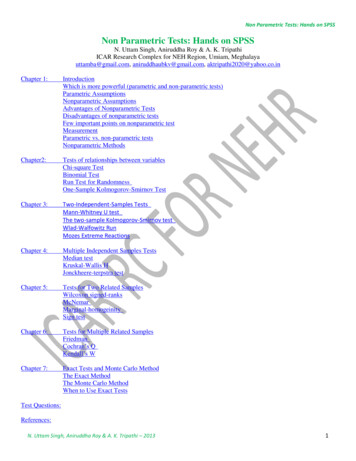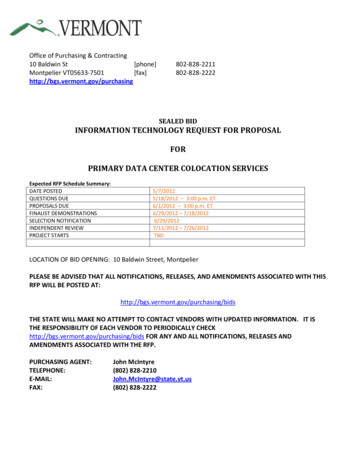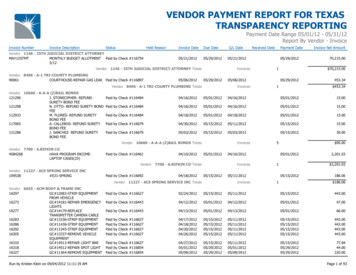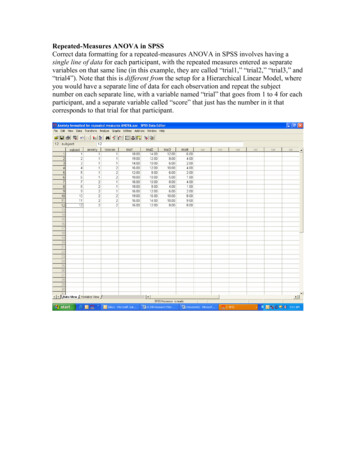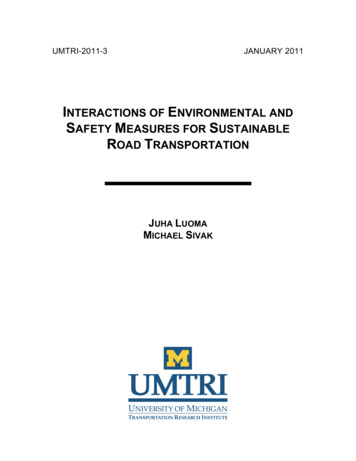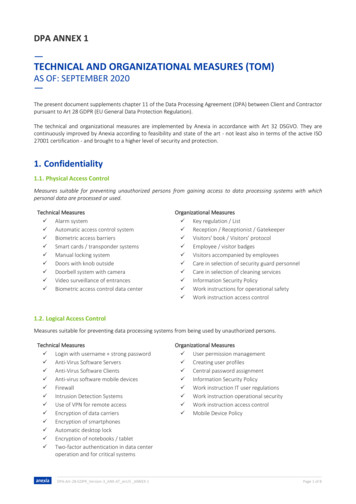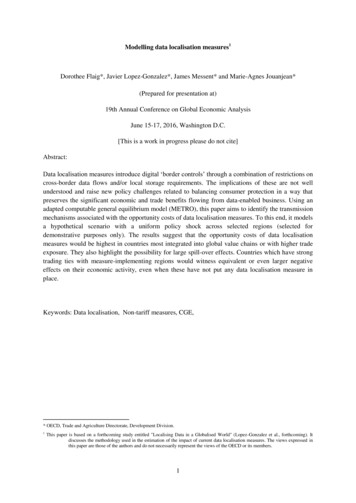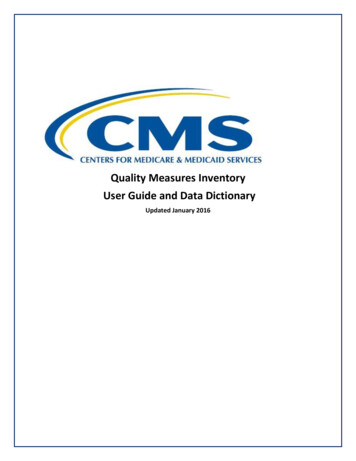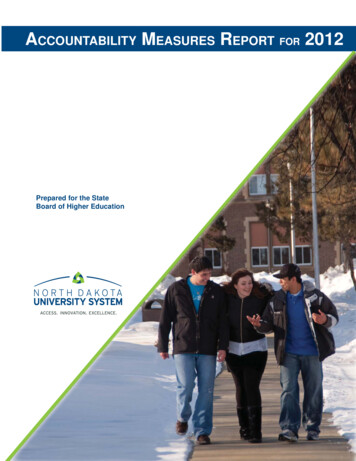
Transcription
ACCOUNTABILITY MEASURES REPORT FOR 2012Prepared for the StateBoard of Higher Education
Five-Point VisionTo become a premier system of higher education in the nationTo offer measurable quality educationTo significantly contribute to distributed economic and social development ofNorth DakotaTo become the best system for student successTo improve quality and keep costs downPathways to Student Success is the FoundationFive Initiatives Propel Us to Our tyPrepared by:North Dakota University System600 E. Boulevard Ave., Dept 215 Bismarck, N.D., 58505-0230Phone: 701.328.2960 Fax: 701.328.2961 Website: ndus.eduDecember 2012
Table of ContentsAn Overview of the North Dakota University System . ii - iiiAn Executive Summary .iv - vWorkforce Training . 1Research Expenditures . 2Student Graduation and Retention Rates . 3Affordability of Tuition and Fees to Lowest Income Families . 4Net College Expenses as a Percent of Median Family Income .5 - 6Average Annual Student Loan Debt. 7Proportion of the Population with Associate Degrees or Higher . 8State General Fund Appropriations and Net Tuition Revenues . 9 - 10Student Share of Funding for General Operations .11Per Capita General Fund Appropriations for Higher Education .12Operating and Contributed Income Ratio .13State and Student Funding Per Degree and Certificate Awarded . 14 - 15Campus Activities Align with Roundtable Expectations . 16 - 19In Other Words . 20 - 21i
An Overview of theNorth Dakota University SystemThe North Dakota University System (NDUS) is a unified system of higher education governed by one board. The systemincludes two doctoral universities, two master’s-level universities, two bachelor’s-level universities and five two-yearcolleges that offer associate and trade/technical degrees.Dickinson State University (DSU)Located in Dickinson, N.D., DSU is near the ruggedly beautifulNorth Dakota Badlands and Theodore Roosevelt NationalPark. DSU offers many bachelor’s degrees including teachereducation, business, computer science, agriculture, nursingand liberal arts, plus many associate degrees. In addition tothe region’s many recreational opportunities, students can beinvolved in varsity and intramural athletics and participate indiverse campus organizations.Degrees: Bachelor’s and associate degrees, certificateprograms and graduate coursesFall 2012 Enrollment: 1,837Telephone: 1.800.279.4295 or 701.483.2175Website: www.dickinsonstate.eduBismarck State College (BSC)Located in Bismarck, N.D., BSC is an innovative communitycollege offering high-quality education, workforce training,continuing education and enrichment programs. The collegeprepares students for hundreds of careers through transfercourses, technical programs and a bachelor’s degree in energymanagement. One of the state’s leaders in online education,BSC offers many programs and courses entirely online. BSC’scampus overlooks the Missouri River and is a vital part ofNorth Dakota’s thriving capital city.Lake Region State College (LRSC)Whether students are seeking technical training or a good placeto begin an undergraduate degree, LRSC in Devils Lake, N.D.,is prepared to help them achieve success. LRSC offers someone-of-a-kind, two-year programs, including law enforcement,wind energy technology and American Sign Language. Itssimulator maintenance technology program – one of only afew in the nation – is a great choice for students interestedin electronics. For students who enjoy the outdoors, DevilsLake and the surrounding region offer hunting, fishing, biking,snowmobiling and more.Degrees: Associate degrees, diploma and certificate programs,and a bachelor of applied science in energymanagementFall 2012 Enrollment: 4,109Telephone: 1.800.445.5073 or 701.224.5400Website: www.bismarckstate.eduDegrees: Associate degrees, diploma and certificate programsFall 2012 Enrollment: 1,974Telephone: 1.800.443.1313 or 701.662.1600Website: www.lrsc.eduDakota College at Bottineau (DCB)Located in Bottineau, N.D., DCB offers more than 30 handson career and technical programs, including horticulture,paramedic technology (EMT), nursing, wildlife and naturalresources. A two-year college in north central North Dakota,DCB also is a great place to prepare for transfer to a universitycampus. Students enjoy a comprehensive college experience,including residence-hall living, student-life activities, andintramural and intercollegiate athletics. Thanks to DCB’sextensive online offerings, students can take college courses nomatter where they live. Varsity athletics include men’s hockey,basketball, football and baseball and women’s volleyball,basketball and fast-pitch softball.Mayville State University (MaSU)Degrees: Associate degrees and diploma and certificateprogramsFall 2012 Enrollment: 774Telephone: 1.800.542.6866 or 701.228.2277Website: www.dakotacollege.eduDegrees: Bachelor’s and associate degrees and certificateprogramsFall 2012 Enrollment: 1,020Telephone: 1.800.437.4104 or 701.788.4842Website: www.mayvillestate.eduLocated in Mayville, N.D., MaSU is a personable rural easternNorth Dakota campus with 70-plus academic programs and anenrollment of more than 1,000 students. Nationally identifiedfor teacher education, MaSU’s many other popular programsinclude business administration, computer informationsystems, and health and physical education. To meet studentneeds for flexibility and convenience, MaSU offers a varietyof technology-enriched delivery options, beginning on campuswhere all full-time students are issued Tablet PC notebookcomputers.iiCreating a University System for the 21st Century
Minot State University (MiSU)including law and medicine; high-quality students and faculty;a varied curriculum; a commitment to graduate education,research and service; and a campus environment rich in culturalresources. UND has established an international reputationfor research and scholarship, notably in aerospace, energy andenvironmental protection, engineering, the health sciencesand nutrition. UND is home to one of the best college hockeyprograms in the nation. Grand Forks is a river city rich inculture and commerce.Located in Minot, N.D., MiSU is North Dakota’s third-largestuniversity and offers more than 60 undergraduate majors andseveral graduate degrees. MiSU has positioned itself to meetgrowth in fields such as criminal justice, management, nursing,social work, management information systems and marketing.Graduates from its master’s program in speech-languagepathology are in demand nationwide. Students benefit fromsmall class sizes, strong athletic programs and an emphasison campus and community engagement. Minot is home to theMinot Air Force Base.Degrees: Professional, doctoral, specialist, master’s andbachelor’s degrees and certificate programsFall 2012 Enrollment: 15,250Telephone: 1.800.225.5863 (1.800.CALL.UND) or701.777.4463Website: www.und.eduDegrees: Master’s, bachelor’s and education specialist degreesand certificate programsFall 2012 Enrollment: 3,560Telephone: 1.800.777.0750 or 701.858.3000Valley City State University (VCSU)Website: www.minotstateu.eduLocated in Valley City, N.D., VCSU has been named to U.S.News & World Report’s best colleges list every year for thepast 15, and was named the No. 1 public regional collegein the Midwest for the second year in a row. VCSU offersmore than 80 bachelor-level degree programs in teachereducation, information technology, business, science, health,communication, social science and fine arts. Online offeringsinclude a master of education degree. Recent facility updatesinclude renovated residence halls and a 10.3 millionrenovation/expansion of the science center. Student activitiesare many and diverse.North Dakota State Collegeof Science (NDSCS)NDSCS offers degrees, certificates and diplomas in more than80 academic options in traditional career, technical studies andliberal arts transfer programs. With locations in Wahpeton andFargo, N.D., NDSCS also offers 170 courses and 13 programsonline.Degrees: Associate degrees and diploma and certificateprogramsFall 2012 Enrollment: 3,066Telephone: 1.800.342.4325Website: www.ndscs.eduDegrees: Bachelor and master’s degrees and certificateprogramsFall 2012 Enrollment: 1,362Telephone: 1.800.532.8641 or 701.845.7101Website: www.vcsu.eduNorth Dakota State University (NDSU)Located in Fargo, N.D., NDSU’s eight colleges offer highquality educational programs for a multitude of successfulcareers. The university’s annual research expenditures exceed 120 million, and undergraduate and graduate students haveexciting opportunities to participate in cutting-edge research.NDSU offers everything from Division I athletics to regionallyrecognized fine arts. NDSU is considered one of the top studentfocused land grant research universities in the country.Williston State College (WSC)Students who pursue associate degrees at WSC can specialize inmore than 70 academic areas and transfer to four-year collegeswith junior status. Students in WSC’s cutting-edge career andtechnology training programs can be job-ready in two years orless. New programs include welding technology and petroleumproduction technology. Other offerings range from nursing todiesel mechanics. Located in Williston, N.D., at the confluenceof the Missouri and Yellowstone rivers, the Williston area offersrugged beauty and a robust, oil-fueled economy.Degrees: Professional, doctoral, master’s and bachelor’sdegrees and certificate programsFall 2012 Enrollment: 14,443Telephone: 1.800.488.6378 or 701.231.8643Website: www.ndsu.eduDegrees: Associate degrees and diploma and certificateprogramsFall 2012 Enrollment: 808Telephone: 1.888.863.9455 or 701.774.4200Website: www.willistonstate.eduUniversity of North Dakota (UND)Located in Grand Forks, N.D., and founded in 1883, theUniversity of North Dakota is characterized by a creative,innovative and entrepreneurial spirit; a solid foundation in theliberal arts; a comprehensive array of colleges and schools,iii
An Executive Summary On average, 14.1 percent of the 2011 median NorthDakota family income was needed to pay for collegeat NDUS four-year and research universities aftergrant aid was deducted. This compares to a nationalaverage of 17.6 percent and 9.9 percent in Wyoming,which had the lowest ratio. On average, 8.6 percentof family income was needed to pay for college atNDUS two-year colleges.The North Dakota University System is pleased toprovide you its 2012 Accountability Measures Report.Borne out of legislative expectations expressed in 2001as part of SB 2003, the University System budget bill,this report demonstrates some of the ways the NDUS isproviding high-quality education and enhancing NorthDakota’s economy.In this dual role, NDUS colleges and universitiesare educating future leaders who will provide thetalent, energy and innovation to keep North Dakotacompetitive in today’s knowledge-based economy.The 2001 legislative action resulted in formation ofthe Roundtable on Higher Education, an initiative thathas contributed to dramatic increases in the estimatedeconomic impact of the University System over thepast 12 years, climbing from 1.6 billion in 1999 to 4.4 billion in FY 2011*. In 2011-12, undergraduate and graduate studentsin North Dakota borrowed an average of 4,467compared to the national average of 4,760 and 4,130 in Maine, which had the lowest average. 50.4 percent of North Dakota’s 25- to 34-year-oldpopulation has associate degrees or higher, comparedto 40.1 percent nationwide. With 12,234 in state and student contributionsper FTE student in the 2009-11 biennium, NorthDakota’s four-year universities, on average, rank12th lowest in the nation compared to the nationalaverage of 13,974 per FTE student. Connecticut hasthe highest average of 22,691 per FTE student.Overall, the colleges and universities that make up theNorth Dakota University System perform very wellwhen compared to other states and national standards.A summary of key findings follows. In FY 2012, 1,765 businesses were served byTrainND, North Dakota’s workforce training system,and 18,466 employees were trained.With 8,765 in state and student contributionsper FTE student in the 2009-11 biennium, NorthDakota’s two-year colleges rank 9th highest in thenation compared to the national average of 6,444per FTE student. Alaska has the highest average of 25,212 per FTE student. Research grew by 19 percent between FY 2008 andFY 2012 with 215 million in research expendituresin FY 2012. In the 2009-11 biennium, net tuition and fee revenuesaccounted for an average of 56 percent of the totalfunding when combined with appropriations atNorth Dakota four-year universities and 41 percentat NDUS two-year colleges. This compares to anational average student share of 50 percent at fouryear universities and 29 percent at two-year colleges. Based on NDUS adjusted graduation rates from allinstitutions, 46 percent of NDUS two-year collegestudents completed degrees within three years, and56 percent of four-year university students completeddegrees within six years. In 2010-11, it took 32.2 percent, on average, of thelowest-quintile North Dakota family income to payfor tuition and fees at NDUS four-year and researchuniversities, compared to 44.1 percent nationally and18.4 percent in Wyoming, which had the lowest ratio.At NDUS two-year institutions, it took 19.2 percent,on average, compared to 15.9 percent nationally and4.4 percent in California, which had the lowest ratio. The average per-capita state general fundappropriation for the 2009-11 biennium was 813, anincrease of 37 percent since the 2001-03 biennium. In FY 2012, the NDUS generated 70 percent of itstotal revenues, either internally from fees for servicesor externally from gifts, grants and contracts.iv
The average cost per degree awarded by NDUS fouryear universities in 2010-11 was 60,603, which isabout 3.6 percent more than the national average. At 31,001 per degree or certificate awarded, Floridaranks best in this measure. The 2010-11 NDUStwo-year college average per degree or certificatewas 26,837, which is 16 percent less than thenational average of 31,917. At 9,011 per degreeor certificate awarded, Louisiana ranks best in thismeasure.State Board ofHigher Education MembersDuaine Espegard, PresidentKirsten Diederich, Vice PresidentTerry HjelmstadSydney HullDon MortonKathleen Neset* Economic Impact of the North Dakota UniversitySystem, NDSU Department of Agribusiness andApplied Economics, 2011.Kari ReichertGrant ShaftJanice Hoffarth, Staff AdviserDoug Munski, Faculty AdviserHamid Shirvani, ChancellorNorth Dakota University Systemv
Workforce TrainingNumber of businessesand employees in theregion receiving trainingHow well is North Dakota’s workforce training system responding to thetraining needs of employers?In FY 2012, 1,765 businesses were served by TrainND, North Dakota’s workforcetraining system, and 18,466 employees were trained.About this MeasureTrainND, North Dakota’s workforcetraining system, is coordinated throughBSC, LRSC, NDSCS and WSC.Performance results are available forFY 2000 through FY 2012. Theseresults demonstrate the continuingresponsiveness of TrainND to a strongdemand for workforce training in thestate.In FY 2000, the year the workforcetraining regions were created bystate statute, 518 businesses receivedtraining through this system. Thenumber rose to 1,818 in FY 2005due to a major one-year contractthat required training to be providedto several hundred businesses. Thenumber of businesses served hasreturned to more normal levels sincethat time.The number of employees whoreceived training in FY 2000 was7,463. By the following year, 10,669employees were trained. This figurehas exceeded 11,000 since FY 2008and reached an all-time high of18,466 for FY 2012. Fluctuations inthe number of businesses served andemployees trained are related to thesize and location of the businesses. Forexample, when training is extended tomore rural areas of the state, smallerbusinesses that have fewer employeesmay be served. Much of the increaseover the last several years can beattributed to training provided foroilfield workers.The workforce training system resultedfrom a 31-member statewide task forceon workforce development and trainingformed in 1998 to research bestpractices in other states and to designa more effective workforce trainingsystem for North Dakota.This initiative was coordinatedby the North Dakota Chamber ofCommerce (formerly the Greater NorthDakota Association) and resulted inrecommendations for the North DakotaUniversity System and the LegislativeAssembly. These recommendationswere enacted into legislation during the1999 Legislative Session.Workforce Training ProvidedFY 2006 through FY 0720082009201020112012Number of Businesses with Employees Receiving 200920102011Number of Employees Receiving Training2012
Research ExpendituresAnnual dollar amount of research expendituresby North Dakota institutions from federal,foundation and business sponsors benchmarkedagainst historical trendsWhat is the level of research expenditures in highereducation?Research grew by 19 percent between FY 2008 andFY 2012 with 215 million in research expenditures inFY 2012.About This MeasureDuring the past five years, researchexpenditures have grown by 19 percentfrom 180.5 million in FY 2008 to 214.9 million in FY 2012.Research Expenditures1, 2FY 2008 through FY 2012MillionsThis does not include research activityat campuses other than UND andNDSU. 220 214.9 207.0 211 201.1 202 186.2 193 184 175 180.5FY 2008 FY 2009 FY 2010 FY 2011 FY 20121As reported by NDSU and UND to the National ScienceFoundation.2Amounts reported in the Accountability Measures Reports priorto FY 2008 included total NDUS research expenditures perfunctional category as reported in the NDUS annual auditedfinancial statements.2
Student Graduation and Retention RatesStudent graduationand retention ratesAre NDUS students completing their degrees?Based on NDUS adjusted graduation rates from all institutions, 46 percent of NDUStwo-year college students completed degrees within three years, and 56 percent offour-year university students completed degrees within six years.About This MeasureEach year, NDUS colleges anduniversities are required to reportgraduation rates to the National Centerfor Education Statistics using theIntegrated Postsecondary EducationData System – or IPEDS – GraduationRate Survey (GRS).Data for the 2011 GRS were generatedby establishment of a cohort (groupof all first-time, full-time students)at each institution. Two-year collegecohorts entered college in Fall 2006and were tracked for three years; fouryear university cohorts entered collegein Fall 2004 and were tracked for sixyears.universities reported a 42 percent rate.This compares to a 2011 national twoyear college rate of 22 percent1 and afour-year university rate of 55 percent.Using the IPEDS cohort and includingthose in the cohort who graduated fromother campuses, the cohort graduationrate is 46 percent for two-year collegestudents and 56 percent for four-yearuniversity students.NDUS institutions also track therate at which full-time freshmenreturn to college the following year.NDUS two-year colleges report a56.8 percent average rate of freshmenwho entered college in Fall 2010 andre-enrolled full time in Fall 2011, andthe four-year universities reporteda 65.2 average percent rate. Thiscompares to a 59.2 percent nationalpublic two-year college retention rateand a 78.6 percent four-year publicinstitution retention rate for 20101.Freshman Retention RatesNDUSOnce a cohort has been established,only a few exceptions, such as militaryservice, an official church mission,Peace Corps service or death, canresult in removal of a student fromthe original cohort. The survey doesnot take into account students whotransfer to then graduate from otherinstitutions; these students are countedas non-completers in GRS, even if theygraduate on time.Two-year collegesFour-year 78.6%2011 Graduation Rates2-yearcollegesNDUS IPEDS-reported campus graduation rateNational IPEDS-reported graduation rate (Fall 2010)1Graduates of other NDUS postsecondary institutionsGraduates of non-NDUS postsecondary institutionsNDUS adjusted graduation In 2011, NDUS two-year collegesreported to IPEDS a 44 percentcompletion rate, and four-yearMost recent data available.Note: This table does not include information on students still enrolled or studentswho have transferred, but not graduated from other institutions, and therefore is notcomparable to adjusted graduation rates published before 2008.Data Sources: ConnectND graduate records, National Student Clearinghouse andIPEDS .3
Affordability of Tuition andFees to Lowest Income FamiliesTuition and fees relativeto the lowest quintile percapita income in the statebenchmarked against thenational average and thestate with the lowest ratioHow affordable are NDUS colleges and universities to North Dakotafamilies who have the least ability to pay?In 2010-11, it took 32.2 percent, on average, of the lowest-quintile North Dakotafamily income to pay for tuition and fees at NDUS four-year and researchuniversities, compared to 44.1 percent nationally and 18.4 percent in Wyoming,which had the lowest ratio. At NDUS two-year institutions, it took 19.2 percent,on average, compared to 15.9 percent nationally and 4.4 percent in California,which had the lowest ratio.About This MeasureThe lowest quintile median family income wasused to respond to this measure because lowestquintile per capita income is not available.This measure demonstrates the percentage ofmedian family income needed to pay for tuitionand fees among those families who have the leastability to pay. Available national data providesstate and national averages for two-year and fouryear and above public institutions.The 2010-11 NDUS average for four-yearcampuses and above was 32.2 percent, which waslower than the national average of 44.1 percent.All NDUS campuses were below the nationalaverage. North Dakota ranked 11th lowest inthe nation while Wyoming ranked the lowest at18.4 percent.The 2010-11 NDUS two-year college averagewas 19.2 percent, the 16th highest in the nationcompared to the national average of 15.9 percent.All NDUS two-year colleges were above thenational average.At 4.4 percent, the state with the lowest twoyear average was California. This is a reflectionof California’s public policy of making collegeaffordable for all by charging little or no tuition.As a result of California’s budget shortfalls, thislikely has changed in recent years with morecosts passed along to students.Tuition and Fees as a Percent of Lowest QuintileMedian Family Income2008-09 through 2010-114-Year and Above PublicUniversitiesDSUMaSUMiSUNDSUUNDVCSUNDUS .7%32.7%34.0%29.8%26.8%31.5%32.2%National Average38.3%40.9%44.1%Wyoming (Lowest Average)15.2%16.5%18.4%2-Year Public %16.8%19.4%19.2%13.6%14.8%15.9%3.3%4.2%4.4%NDUS AverageNational AverageCalifornia (Lowest Average)Data sources: Tuition and fees from 2008, 2009 and 2010 IPEDS dataand lowest quintile median family income from U.S. Census Bureau 2009,2010 and 2011 American Community Survey (ACS). All data compiledand provided by NCHEMS. [Note: North Dakota data has been adjustedto reflect tuition and fee rates for 15 credit hours per semester.]4
Net College Expenses as aPercent of Median Family IncomePercent of median familyincome (average of allincome groups) needed topay for college expensesafter deducting grant aidbenchmarked against thenational average and the statewith the lowest ratioHow affordable are NDUS colleges and universities to all families?On average, 14.1 percent of the 2011 median North Dakota family incomewas needed to pay for college at NDUS four-year and research universitiesafter grant aid was deducted. This compares to a national average of17.6 percent and 9.9 percent in Wyoming, which had the lowest ratio. Onaverage, 8.6 percent of family income was needed to pay for college atNDUS two-year colleges.About This MeasureThis measure demonstrates thepercentage of median family income(average of all income groups) neededto pay for college expenses afterdeducting grant aid.Available national data includes2010-11 state and national averagesfor two-year and four-year and abovepublic institutions. The NDUS averagefor four-year and above campuses was14.1 percent, which was lower than thenational average of 17.6 percent. NorthDakota was 10th lowest in the nation.The state with the lowest average wasWyoming at 9.9 percent.As explained in Footnote 1 on Page 34,because room and board charges werenot available (or applicable) for mostpublic two-year community colleges inother states, the national data includesfour-year room and board rates for thecommunity colleges, assuming thoseliving expenses would apply to allstudents whether or not they lived oncampus. Using the average room andboard rates for four-year universitiesfor comparison, net college costs forNDUS two-year community collegesranged from 6.9 percent to 11.2 percentof the median family income (with anaverage of 10.4 percent) compared tothe national average of 13.1 percent.The state with the lowest average wasWyoming at 9.6 percent; North Dakotawas 7th lowest in the nation.Using NDUS two-year communitycollege room and board rates ratherthan the four-year university average,5North Dakota’s actual net costsaccounted for 4.9 to 9.9 percent or, onaverage, 8.6 percent of family income.Several factors contributed to thedecrease in percentages for NDUSinstitutions from 2009-10 to 2010-11,including an increase in the statemedian income and increases inaverage Pell Grants and state aid with2010-11 being the first year of the newstate Academic and Career TechnicalEducation Scholarship Program. Inaddition, a change in IPEDS reportingresulted in an increase in the amount ofgrant aid reported in 2010-11 comparedto previous years.Continued on Page 6
Net College Expenses as a Percentof Median Family Income (continued)Net College Expenses as a Percent ofMedian Family Income of All Income Groups2008-09 through 2010-114-Year and Above Public 1%15.3%UND15.8%16.0%15.1%VCSU10.0%10.3%8.3%NDUS Average15.1%15.2%14.1%National Average16.9%17.2%17.6%Wyoming sumingAverage 4-yrRates forRoom andBoard for AllStates 1AssumingAverage 2-yrRates forRoom andBoard for NDInstitutions 2AssumingAverage 4-yrRates forRoom andBoard for AllStates .5%9.6%11.3%9.3%10.4%8.6%2-Year PublicInstitutionsWSCNDUS AverageAssumingAverage 2-yrRates forRoom andBoard for NDInstitutions 2AssumingAverage 4-yrRates forRoom andBoard for AllStates 1National Average12.9%12.9%13.1%Wyoming (LowestAverage)9.2%9.3%9.6%AssumingAverage 2-yrRates forRoom andBoard for NDInstitutions 211 Because room and board charges are not available (or applicable) for most public two-year colleges, the IPEDS data included fouryear room and board rates for the two-year colleges, assuming those living expenses would apply to all students whether or not theylive on campus.2Because North Dakota two-year colleges do offer room and board plans, actual two-year averages also are presented.Data sources: Tuition and fees from 2008, 2009 and 2010 IPEDS data and median family income from U.S. Census Bureau 2009, 2010a
Williston State College (WSC) Students who pursue associate degrees at WSC can specialize in more than 70 academic areas and transfer to four-year colleges with junior status. Students in WSC's cutting-edge career and technology training programs can be job-ready in two years or less. New programs include welding technology and petroleum

